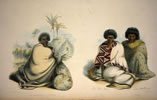Purpose
The government newspapers, published under several titles from 1842 to 1877, pursued a single purpose. This was expressed in Ko te Karere o Nui Tireni (1842–46) as instructing Māori in the customs, laws and government of the Pākehā, and, more directly, in The Maori Messenger – Ko te Karere Maori (1849–54) as civilising Māori. These ends were served by government employees as editors and advisors, including Walter Buller, James Grindell and Donald McLean.
Illustrating divisions
There were other aims too: to inform Pākehā and Māori about each others’ customs and to invite Māori opinion on the government. Te Waka Maori o Ahuriri (1863–71) was intended to generate goodwill and unity between Māori and Pākehā. But this paper and its successor, Te Waka Maori o Niu Tirani (1871–77), are witness to the divisions between the two groups, and between Māori and government – and Māori and Māori. They span the period of wars – on the East Coast and in Taranaki and Waikato – and of highly contentious issues, such as the sale of land, the jurisdiction of the Native Land Court and Māori representation in Parliament. As a result there are often forceful views in the correspondence columns of the two Waka Maori.
Content
All the government newspapers are a rich source of social and political history. Their content is mirrored, to a greater or lesser extent, in the other Māori-language newspapers. They document explanation and discussion of laws, Native Department policy, argument over land sales and use of land (for roads, railways and telegraph), meetings between Māori and government officials (often with speeches by chiefs) and disputes between Māori and Pākehā. They traverse the social and domestic, with reports about daily life, health, education, churches and local events; and articles and information about agriculture, farming, commerce and shipping. They include a diverting array of advertisements from Māori and Pākehā.
Local and foreign content
Māori culture and tribal life is reflected in excerpts of, and debates about, history and genealogy; quotation of songs, incantations and sayings; reports on local meetings and events; and accounts of the lives of chiefs. The foreign content is diverse, including news from around the world and articles about English and European history. Christian scripture and precepts thread through editorials and articles – as well as the correspondence from Māori.
Letters from the chiefs
Early government newspapers provide valuable evidence of Māori chiefs’ opinions about colonisation. Letters written to Governor Robert Fitzroy were published in Ko te Karere o Nui Tireni in January 1844. Beginning with a short greeting of welcome to him, five Waikato signatories, headed by Te Wherowhero, and eight Ngāti Whātua chiefs led by Āpihai Te Kawau, wrote about the Treaty of Waitangi, European customs, the Crown and how land should be sold. Fitzroy’s replies followed.
Māori letters to government papers
From the outset Māori (and Pākehā) wrote to the government press. They wrote, for example, about the bills and laws before Parliament, the workings of the courts, sale of land, trade and commerce, and peaceful and military engagement between tribes, settlers and government. They also wrote about tribal matters. They used the papers pragmatically – to advertise land, stock or produce for sale, or to find work. In many of their contributions, Māori chose their own expressive style to inform and make a point – for instance, giving a terse, rhythmic history of some land with relevant genealogy and geographic boundaries, then warning (Pākehā and Māori) about dishonest sale and that the land would not be given up. In their use of the press Māori too had a desire to instruct.









